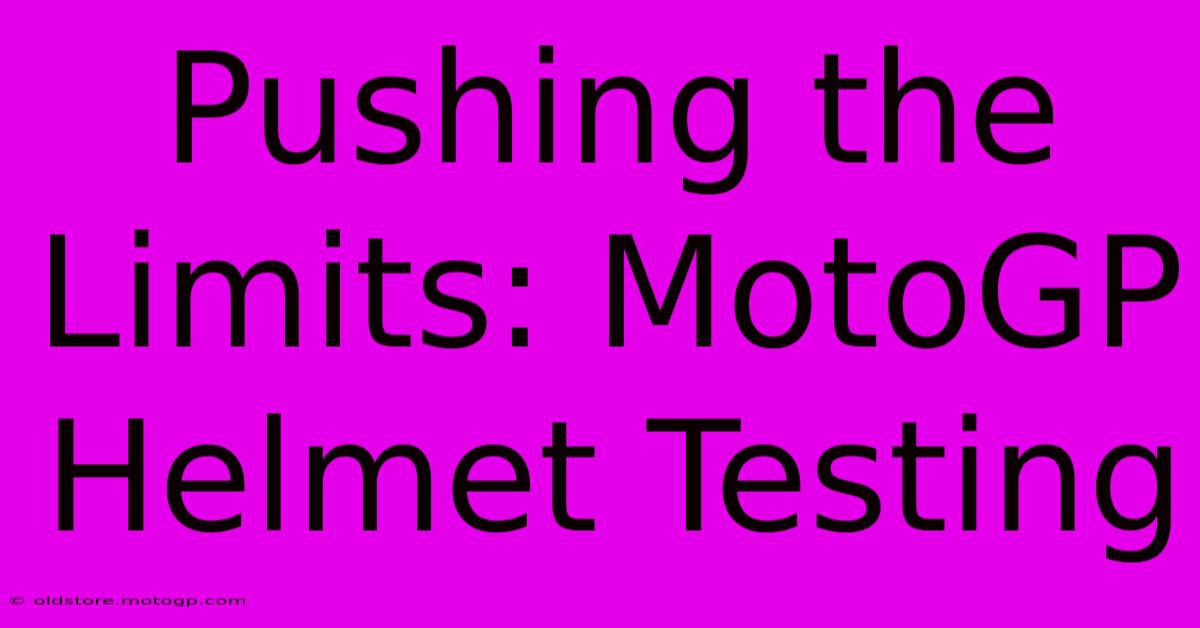Pushing The Limits: MotoGP Helmet Testing

Table of Contents
Pushing the Limits: MotoGP Helmet Testing
The roar of the engines, the blur of speed, the breathtaking skill – MotoGP is a spectacle of human potential and technological marvel. But behind the adrenaline-fueled races lies a crucial element often overlooked: the safety gear, particularly the MotoGP helmet. These aren't just helmets; they're sophisticated pieces of engineering designed to withstand unimaginable forces. This article delves into the rigorous testing process these life-saving devices undergo, pushing the limits of safety standards to protect the world's best riders.
The Importance of Rigorous Testing
MotoGP riders experience extreme G-forces during crashes, impacting their heads with immense power. A helmet's performance in such scenarios is critical. Helmet testing isn't a simple drop test; it's a multi-faceted process ensuring the helmet performs flawlessly under various conditions. Manufacturers employ cutting-edge technology and relentless scrutiny to achieve the highest standards.
Key Testing Procedures
The testing procedures are exhaustive, incorporating:
-
Impact Testing: This is the cornerstone of helmet testing, simulating impacts at various angles and speeds, often exceeding those encountered in real-world crashes. The helmet's ability to absorb and dissipate energy is meticulously assessed. Data acquisition systems record every detail, providing a thorough understanding of the helmet's performance.
-
Penetration Testing: Sharp objects, from track debris to other racers' machines, can pose significant threats. Penetration testing evaluates the helmet's resistance to such hazards, ensuring the shell remains intact and protects the rider's head.
-
Rotation Testing: Rotational forces during crashes are particularly dangerous. This testing simulates these forces to evaluate the helmet's ability to mitigate rotational acceleration and minimize brain injury. Advanced testing equipment is vital in this process.
-
Material Testing: The materials used in MotoGP helmet construction are rigorously tested for their strength, durability, and impact absorption properties. From the outer shell to the inner lining, every component undergoes scrutiny. Advanced composite materials are constantly being researched and implemented to enhance safety.
Beyond the Lab: Real-World Considerations
While laboratory testing is paramount, manufacturers also consider real-world factors:
-
Aerodynamics: The helmet's design plays a crucial role in aerodynamic performance, influencing stability at high speeds and reducing wind resistance. Wind tunnel testing is incorporated to optimize the helmet's shape and design.
-
Ventilation: Effective ventilation is crucial for rider comfort and performance. Testing ensures optimal airflow to prevent overheating and maintain clear vision.
-
Weight: While safety is paramount, weight is also a factor. The helmet should be lightweight to minimize rider fatigue without compromising safety.
-
Communication Systems: Modern helmets incorporate communication systems for rider-to-team communication. Testing ensures these systems function effectively without compromising the helmet's structural integrity.
The Future of MotoGP Helmet Testing
The pursuit of enhanced safety is an ongoing process. Advanced technologies like sensors and data analysis are being integrated into helmet testing to provide even more detailed insights. The focus is on understanding the complex biomechanics of head injuries and developing helmets that offer superior protection. This continuous refinement ensures MotoGP riders receive the best possible protection, enabling them to push the limits of the sport with confidence.
Conclusion:
The rigorous testing process behind MotoGP helmets highlights the dedication to safety within the sport. These helmets are not mere pieces of equipment; they represent a commitment to protecting the riders who dare to push the boundaries of speed and skill. The relentless pursuit of improved safety through advanced technology and stringent testing is what allows the sport to continue to thrive, balancing the thrill of competition with the paramount importance of rider well-being.

Thank you for visiting our website wich cover about Pushing The Limits: MotoGP Helmet Testing. We hope the information provided has been useful to you. Feel free to contact us if you have any questions or need further assistance. See you next time and dont miss to bookmark.
Featured Posts
-
Dont Get Towed Cota Parking Regulations Explained
Feb 25, 2025
-
Indulge In Luxury At Club Si Austin F1
Feb 25, 2025
-
Cota Merch The Perfect Way To Remember Your Race Day
Feb 25, 2025
-
Master The Track Motorcycle Track Days At Cota
Feb 25, 2025
-
Moto Gp Race Tracks Mastering The Art Of Acceleration
Feb 25, 2025
